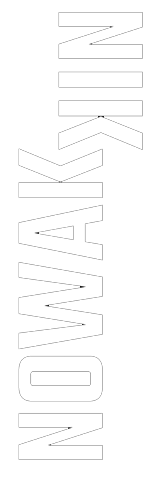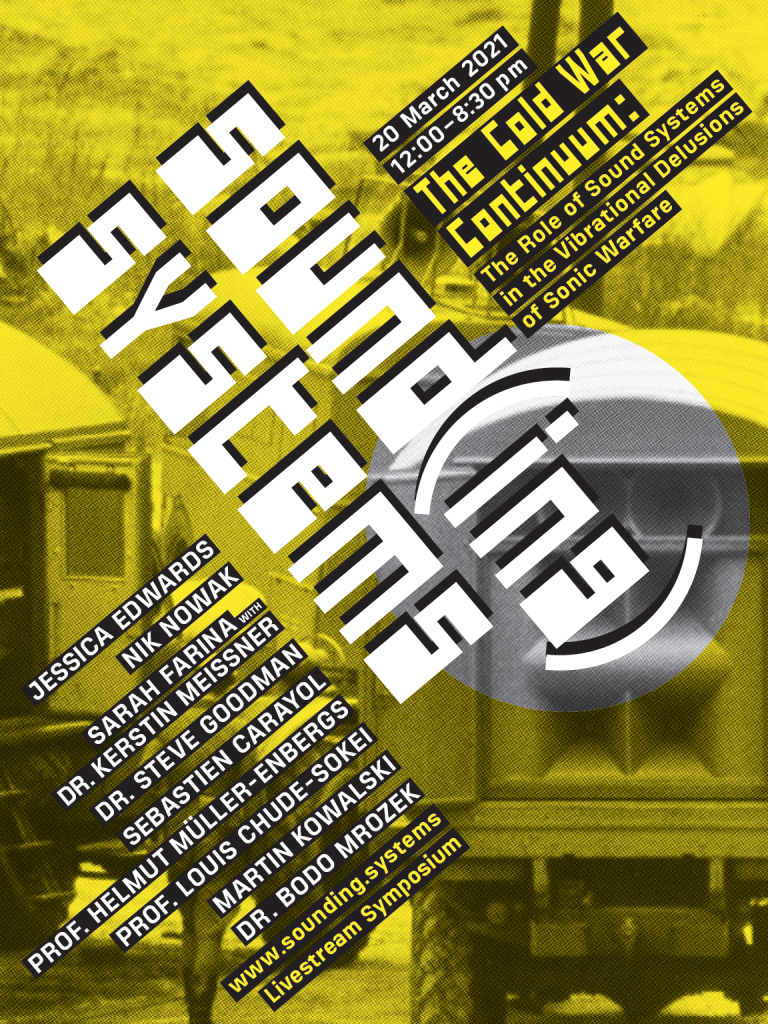SOUND(ING) SYSTEMS
20. March 202 1 / 12 pm – 20.30 pm
Live Stream
What factors might account for both how, and why, sound system culture, and the medium of sound itself, have become gravitational spheres to which the military, covert government agencies, cultural producers, and theorists alike have been increasingly drawn since the onset of the (first) Cold War?
Within the apparent re-awakening, and cultivation, of a new strain of Cold War hostilities, there can be found a trajectory of significant, but perhaps yet-to-be sufficiently mapped, relational events: events that, arguably, created the germinal conditions for the technological and sonic potentialities of sound—and sounding—systems’ capacities to equally impact, and reconfigure, contemporary global politics, state warcraft, and the militarisation of everyday life, on the one hand; and, on the other, the visual arts, philosophical enquiry, scientific research and sound studies, race, feminist and queer discourses and praxes, and club subculture, therein becoming an increasingly vital tool in the armoury of cultural politics.
A one-day programme of discussions, lectures, and audio-visual presentations accompanying, and reaching its apogee in the sound and visual artist Nik Nowak’s exhibition Schizo Sonics and performance of A War of Decibels, at Kindl Centre for Contemporary Art (Berlin), the symposium, The Cold War Continuum: The Role of Sound Systems in the Vibrational Delusions of Sonic Warfare, brings together renowned sonic theorists and philosophers, Cold War cultural commentators, with cultural practitioners from the visual arts, DJ and sound system culture, and the curatorial and museum exhibition context. In so doing, the symposium aims to uncover the unsuspected homologies—that is, the unanticipated soundings and co-evolutions—that exists between art, race, and the legacies of the Cold War’s ideological sonopolitics, contemporaneous military technologies and practices, and the development of sound system culture.
Revolving around the critical dissection of a series of punctual political events, the invited discussants will consider the operative modalities through which the sonic potential of sound(ing) systems—entangled both historically and contemporaneously within wider sonopolitical battles of attraction and repulsion, of power, control and dominance—have been harnessed and/or weaponised by competing ideological and cultural factions, and how antithetical these modes really are.
From the near-forgotten history of Berlin’s Lautsprecherkrieg, (‘Loud Speaker War’) beginning in 1961, with its mobile sound system clashes between East Germany’s Rôte Hugos and West Germany’s Studio am Stacheldraht, (‘Studio at the Barbed Wire’), and the escalating, retaliatory sonic assaults across the German-German border in a race for the spatial and psychical domination of the divided Berlin sky and its people beneath it; to the adversarial eavesdropping and secret monitoring practices of the NSA and KGB “listening stations” at the now topologically iconic Teufelsberg and its enemy counterpart at Karlshorst as a technical and technological arms race and speculative analogy to the Berlin Wall; to the surprising role and entanglement of Jamaican sound systems within this Cold War continuum, in first the island’s revolutionary decolonial struggle for Independence and self-determination, and then later, in the sonic proxy war, where the simulacrum of ritual violence enacted in the noise-weapons of the sound system clashes would turn deadly during the Jamaican General Elections of the 1970s as the island divided along sonopolitical lines, affiliating with either Michael Manley’s socialist-leaning People’s National Party (PNP), or Edward Seaga’s—(oft-called Edward C.I.A.-ga)—Jamaica Labour Party (JLP); to Cuba, and the psychologically and viscerally disruptive “acoustic attack” in 2017 on the US Cuban Embassy of which there is much obfuscation pertaining to the (ab)use of un-sound systems of infra- and ultra-sound and the wielding of that most immaterial of materials, that this event has generated its own mythos, become cloaked in hyperstition; and to arrive then, in the echo of this most intricate history, to the contemporary moment and in the spaces – gendered, queer, ecological – opened up by its complexities in the politics of the dancefloor.
The Cold War Continuum: The Role of Sound Systems in the Vibrational Delusions of Sonic Warfare, thus aims at articulating the sonic nexus that exists between Berlin, Jamaica and Cuba, via sonopolitical excursions into the spaces and political events in-between, to proffer an exploration of how thinking with, and through, sound system culture, might yet be deployed for creating new modes of, (and for), political expression and dissent, to counter the creeping return and propaganda of a (new) Cold War division of the world.

